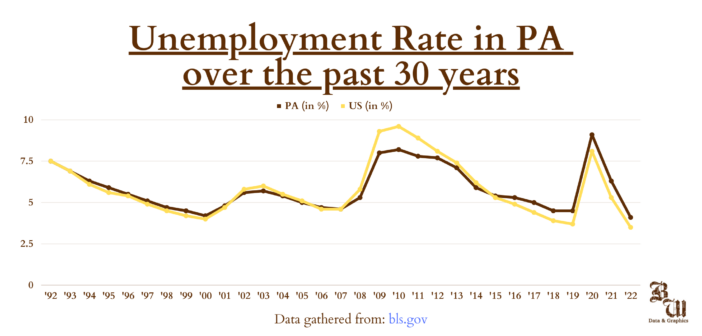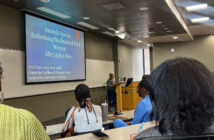Pennsylvania’s unemployment rate is the lowest it has been since 2000.
The Pennsylvania Department of Labor and Industry released their preliminary report on employment last month, reporting a record low unemployment rate of 4.1% as of September.
Since the spike to 16.5% in April 2020, the unemployment rate has been showing improvement. Before the pandemic, Pennsylvania’s unemployment rate was around 5%.
“We’ve been recovering and adding jobs back, but we’ve also lost some labor force since the pandemic, including a lot of people retiring,” said Lauren Riegel, statistician supervisor for the Department of Labor and Industry. “So in addition to recovering, some people leaving the labor force has also impacted it.”
After the height of the pandemic, the Department of Labor and Industry took various initiatives to invest in recovering from COVID-19’s impact on unemployment in Pennsylvania.
Dan Kuba, acting deputy secretary for workforce development at the department, credited this percentage drop to the department’s “multi-faceted approach.” Kuba described a focus on grand opportunities and looking at groups with the highest potential to contribute to the workforce.
“We’ve been taking a look at new college graduates, taking a look at the unemployed that are still out there and have fallen off the radar, looking at those that are in part-time employment and are seeking better opportunities,” Kuba said.
The department has put in place a number of projects over the last two years to tackle the issue of unemployment.
One policy investment is the Industry Partnership Program, where the department looks at transportation, manufacturing, healthcare and construction, targeting primary employment occupations and industries in Pennsylvania. The program has created over 245 training programs needed by each industry.
The department has also invested in the digital literacy world by providing micro-grants to neighborhoods in an effort to increase digital literacy. The investment is a direct result of employers identifying digital literacy as a priority, Kuba said.
Kuba said the current employment situation is a “tight labor market,” meaning there are far more opportunities than current potential employees are applying for.
There has been pressure to increase wages because of the amount of jobs lost, and employers have been struggling to fill those vacancies without increasing wages, Kuba said.
“Even though the unemployment rate is at a record low, that doesn’t necessarily mean that everyone can get a job,” Kuba said. “We have seen wages go up and lower paying industries struggling to find people. For example, restaurants, leisure and hospitality.”
Karen Pooley, political science professor, said she believes this drop means that more people who are in the workforce have found work.
Pooley said while this should be unmitigated good news, uncertainty remains.
“In some cases, the bad news may be in the things that the unemployment rate doesn’t tell us,” Pooley said. “How many people have given up on work? What’s the quality of life like for those who have?”
She said as it has gotten easier for people to find work, people have been able to be more selective about the work they choose to do.
The drop in unemployment and increase in available jobs has affected certain industries more than others.
Malaysian restaurant Jenny’s Kuali opened in 2012 on the South Side and closed in September of this year.
Jenny Lim, co-owner of Jenny’s Kuali, said they had to close partly because of their inability to find staff.
“I didn’t know where I was going to find people to put on the schedule,” Lim said. “I was working alone with another person. He also had to do the dishes, prep the food and cook. He would go there to catch up around 7 or 8 o’clock in the morning, and not be done until 9 or 10 o’clock.”
Lim believes people are now looking for easier work compared to the demanding restaurant schedule.
“In the kitchen, it’s long hours and hard work. A lot of restaurant owners I’ve talked to said they couldn’t find reliable help,” Lim said. “We weren’t the only ones struggling.”
To maintain the low unemployment rate, the Department of Labor and Industry is continuing to maintain the business and education partnership.
The department aims to make sure that people understand career pathways and the sheer amount of available jobs, Kuba said.
“Tight labor markets are good in one aspect, but we also have greater demand from employers, and we need skilled employees to fill those positions,” Kuba said.






Comment policy
Comments posted to The Brown and White website are reviewed by a moderator before being approved. Incendiary speech or harassing language, including comments targeted at individuals, may be deemed unacceptable and not published. Spam and other soliciting will also be declined.
The Brown and White also reserves the right to not publish entirely anonymous comments.